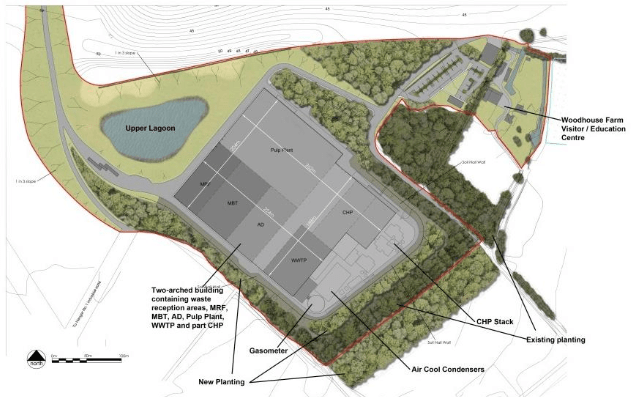This comes after a long-standing debate over the height of the chimney, with the Environment Agency previously favouring a taller chimney it said would lower emissions.
However, in an announcement published by the Agency today (4 June) , it said that its “technical assessment concluded that the proposed design changes will deliver an equivalent level of environmental protection compared to the rigorous standards required under the current permit”.
The plant will form part of an Integrated Waste Management Facility with the capacity to treat up to 850,000 tonnes a year, which will include a materials recycling facility, an anaerobic digestion plant and an MBT plant.
The proposed layout of the site
History
Gent Fairhead was first granted planning permission for the plant in 2010 with a stack height of 35 metres.

In December 2016 the Agency refused an environmental permit for the facility, saying Gent Fairhead failed to show how it would use Best Available Techniques to minimise emissions from the facility, mainly because of the proposed chimney stack of 35 metres.
At that time the Agency said the plant should incorporate a higher stack of a minimum of 70 metres, which was more in keeping with facilities of a similar size (see letsrecycle.com story).
In 2018, pan-European waste company Indaver entered the project with an agreement which saw it become joint operator of the facility.
However, in January this year, the Agency said it was “proposing to accept” the permit variation application from Gent and Indaver, subject to a public consultation on the proposed changes.
Decision
Confirming the decision today, Frank Saunders, team leader at the Environment Agency said the Agency was satisfied the stack height meets the legal requirement for Best Available Techniques.
“Our technical assessment concluded that the proposed design changes will deliver an equivalent level of environmental protection”
“Following detailed technical scrutiny of the proposals over the last 20 months, together with careful consideration of all received consultation responses, we have now decided to issue a permit variation.
“Our technical assessment concluded that the proposed design changes will deliver an equivalent level of environmental protection compared to the rigorous standards required under the current permit.
“We recognise that we are now allowing a stack height – 35 metres – that we originally rejected in 2016.
“However, we believe that a lower stack is acceptable but only in conjunction with the significantly lower emission limits.
“We are also satisfied that the additional pollution control techniques proposed by the company will ensure that the stricter emission standards can be met in practice.
‘Climate resilience’
In a statement published by Indaver last night (3 June), the company said the facility will operate to strict emissions limits to ensure that a lower stack height does not lead to any reduction in local air quality, and help with “climate resilience”.
“The proposed facility will contribute to climate resilience and net zero carbon targets by diverting biodegradable waste from landfill and from export abroad, thereby reducing harmful greenhouse gas emissions and by producing renewable energy. It will also contribute to the circular economy through maximum recovery of energy and valuable materials such as metals and aggregate from waste.
“By incorporating a 49 MW EfW facility, the proposed EfW will not only work alongside recycling efforts made by the local community and therefore benefit the facility’s surrounding area, but it will also supply enough electricity to power over 60,000 homes.”











Subscribe for free